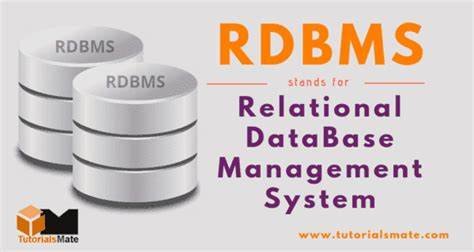Databse management system
A Relational Database Management System (RDBMS) is a type of database management system (DBMS) that stores data in a structured format using rows and columns. It allows users to create, update, manage, and retrieve data in a relational database. RDBMSs are based on the relational model introduced by E. F. Codd in 1970. Key features and components of an RDBMS include:
Tables: Data is organized into tables, where each table is a collection of rows and columns. Each row represents a record, and each column represents an attribute of the record.
SQL (Structured Query Language): SQL is the standard language used to interact with an RDBMS. It allows users to perform various operations such as querying, inserting, updating, and deleting data.
ACID Properties: RDBMSs ensure data integrity and reliability through the ACID properties—Atomicity, Consistency, Isolation, and Durability. These properties guarantee that database transactions are processed reliably.
Primary Keys: A primary key is a unique identifier for a record in a table. It ensures that each record can be uniquely identified and accessed.
Foreign Keys: A foreign key is a field in one table that uniquely identifies a row of another table. It establishes a relationship between the tables, enforcing referential integrity.
Indexes: Indexes are used to improve the speed of data retrieval operations on a database table. They work similarly to an index in a book, allowing for quick look-ups of data.
Normalization: This is the process of organizing data to reduce redundancy and improve data integrity. Normalization involves dividing large tables into smaller, related tables.
Transactions: A transaction is a sequence of one or more SQL operations that are executed as a single unit. RDBMSs ensure that transactions are completed successfully or rolled back in case of an error.
Popular RDBMSs include:
- Oracle Database: Known for its robustness and extensive feature set, widely used in enterprise environments.
- Microsoft SQL Server: A popular RDBMS for Windows environments, offering integration with other Microsoft products.
- MySQL: An open-source RDBMS that is widely used for web applications and known for its speed and reliability.
- PostgreSQL: An open-source RDBMS known for its advanced features and compliance with SQL standards.
- SQLite: A lightweight, embedded RDBMS commonly used in mobile applications and small-scale projects.
RDBMSs are widely used across various industries for managing and analyzing data due to their structured approach and support for complex queries and transactions.
.jpg)
Congratulations, your post has been upvoted by @upex with a 0.21% upvote. We invite you to continue producing quality content and join our Discord community here. Visit https://botsteem.com to utilize usefull and productive automations #bottosteem #upex